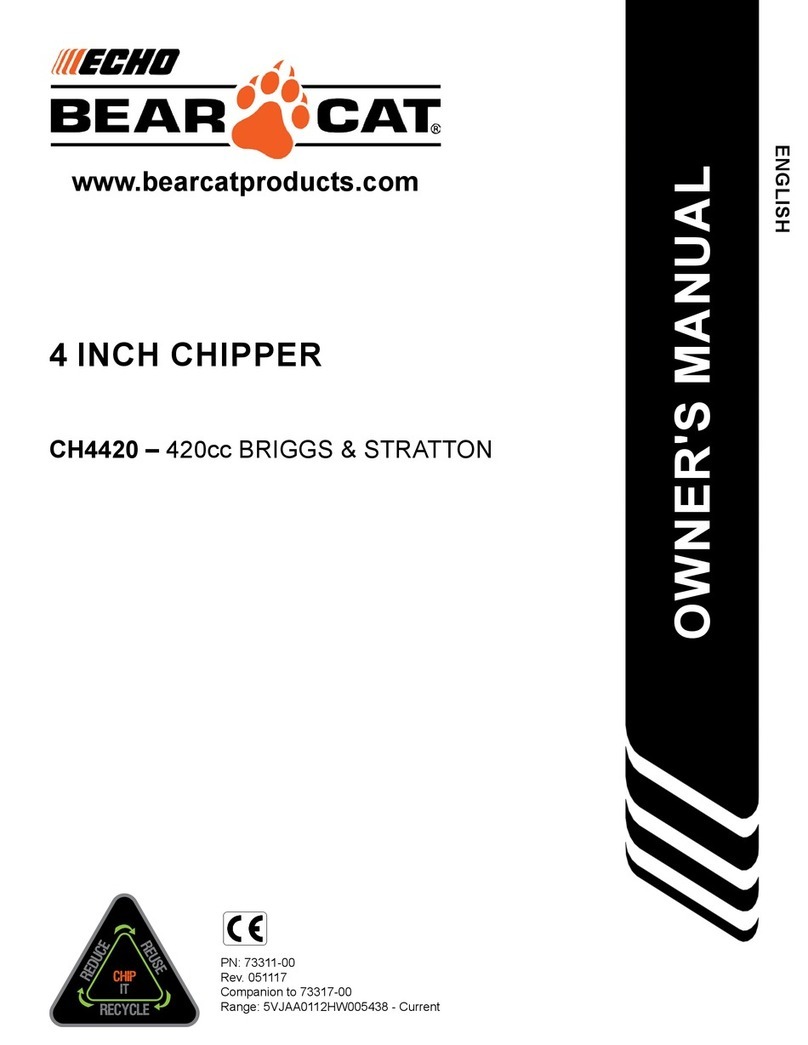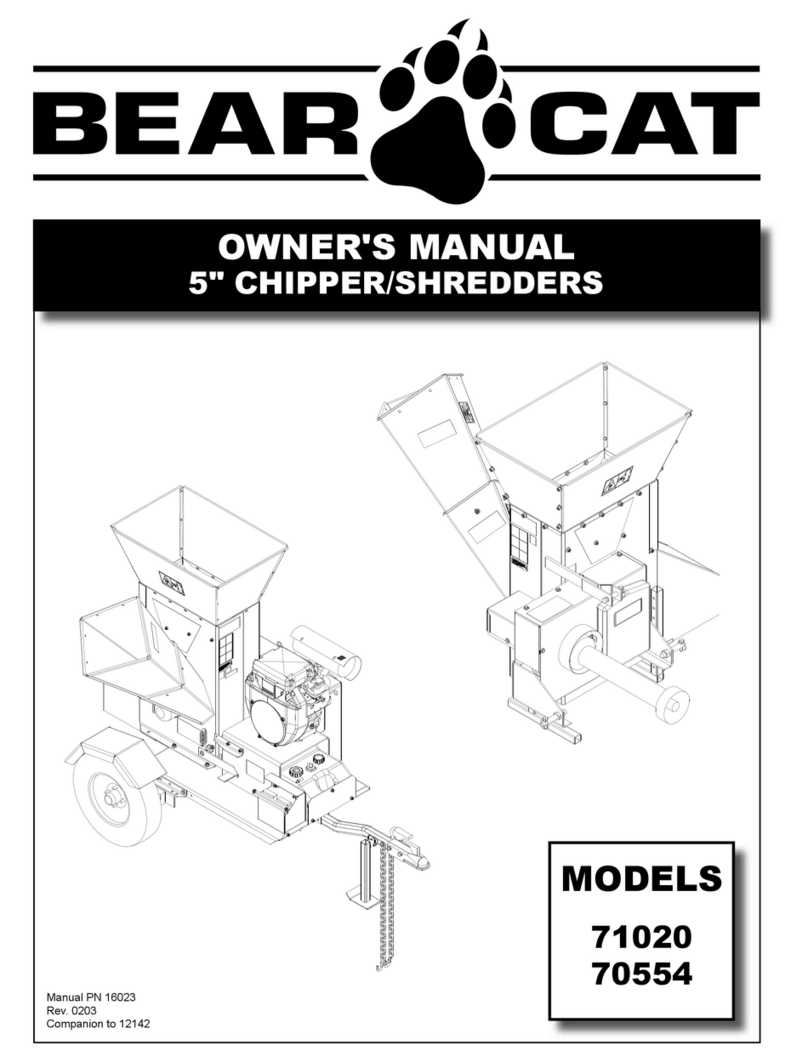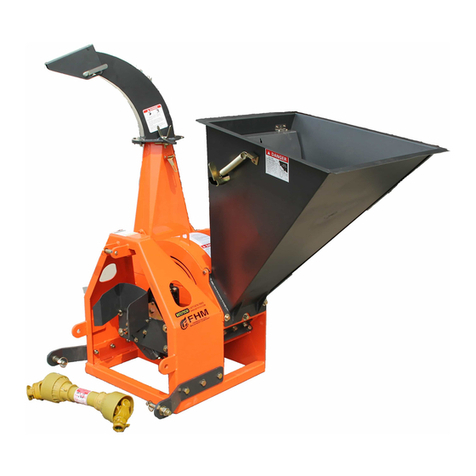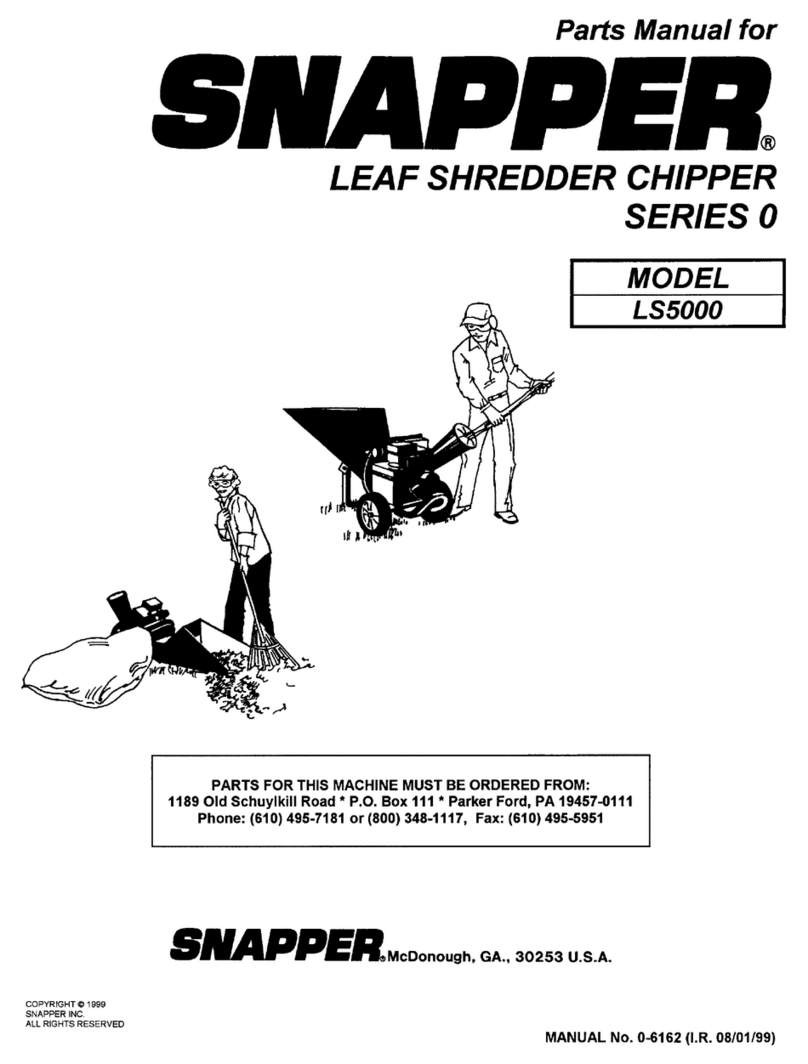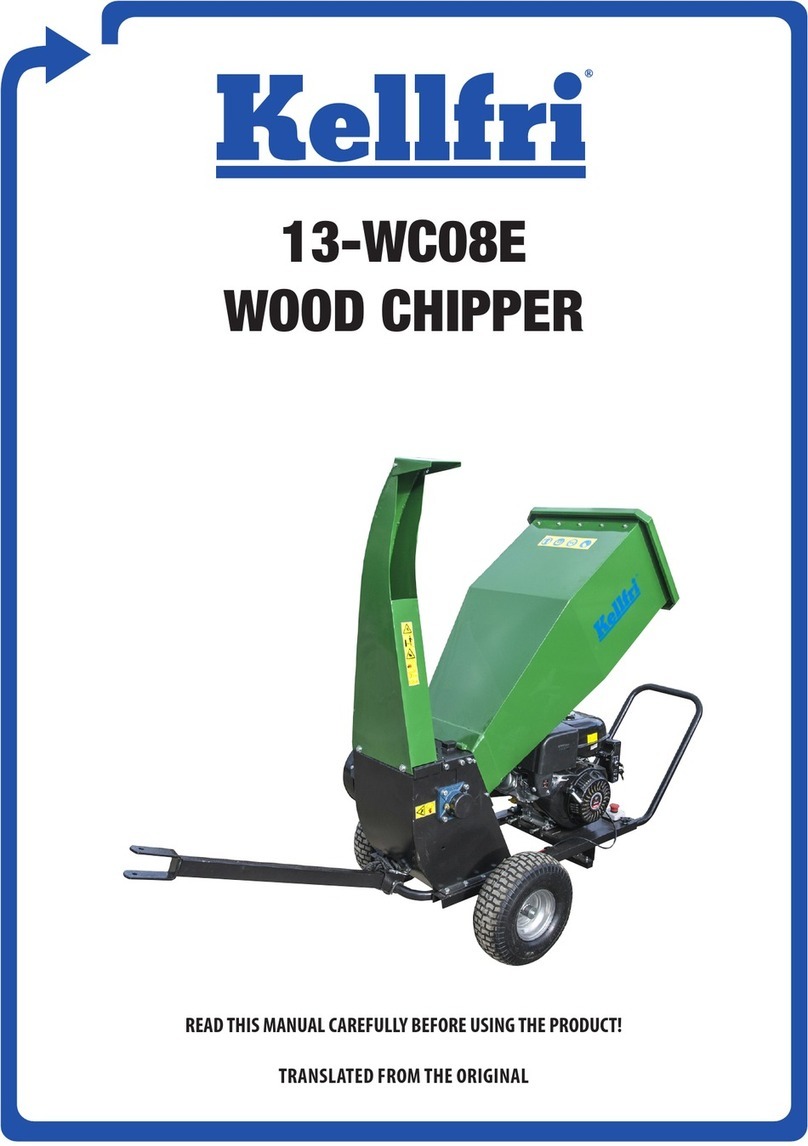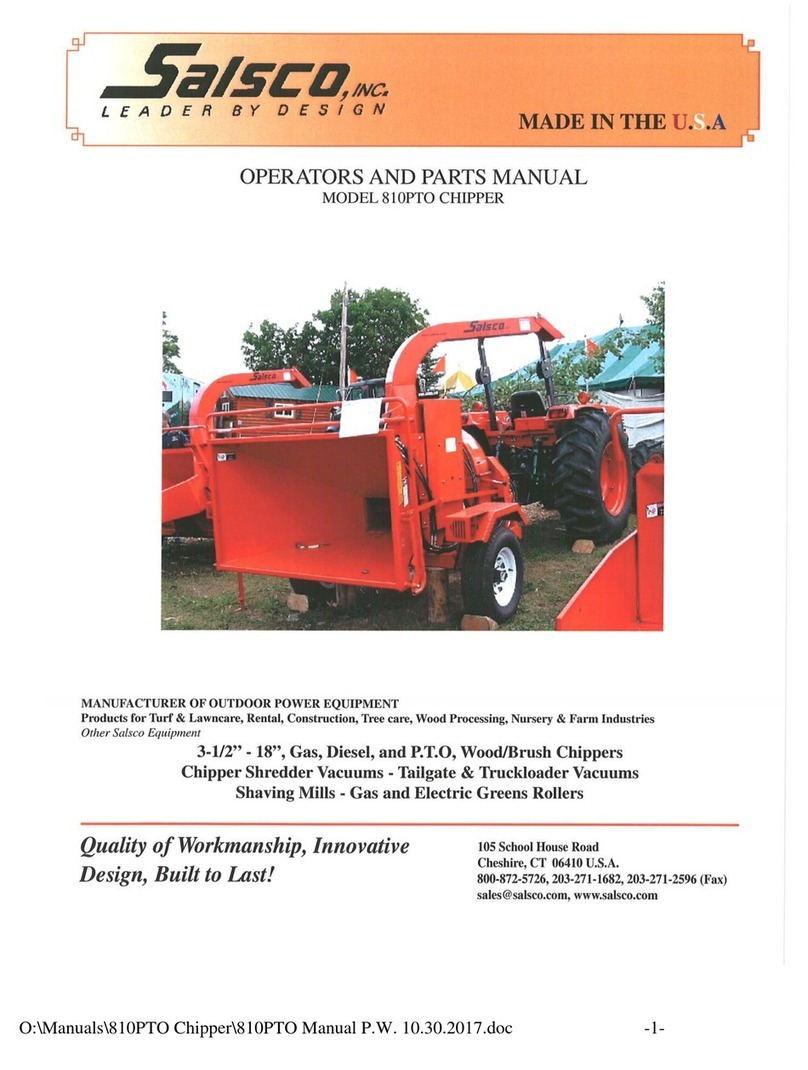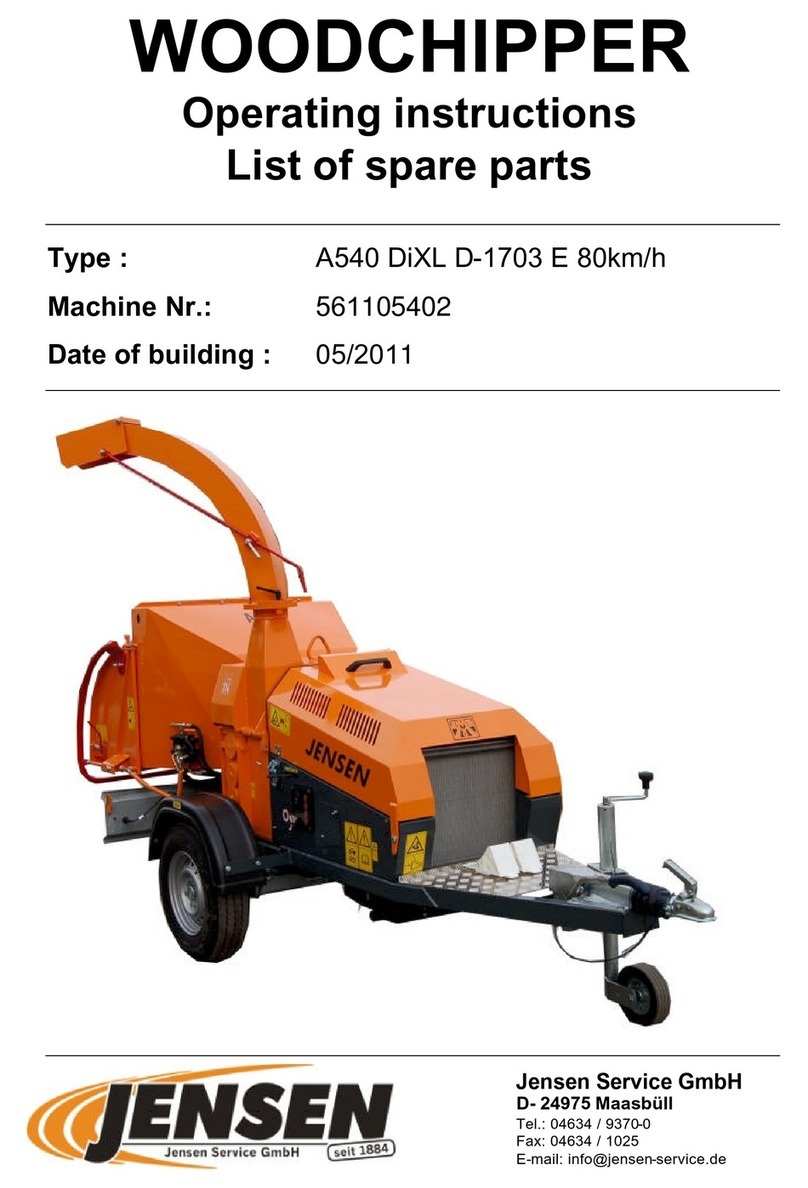Bearcat CH911DH User manual

ENGLISH ESPAÑOL FRANÇAIS
BEARCATPRODUCTS.COM// 888.625.4520
OWNER’S MANUAL
ENGLISH
1.1L DIESEL KUBOTA®
P/N: 78636-00
Revision: 20220822
VIN Range: 5VJAA0411NW006958 - Current
Companion to P/N: 78640-00

Before You Begin
© 2022, Crary®Industries, All rights reserved. Produced and printed in the U.S.A.
HOW TO CONTACT Crary Bear Cat
ADDRESS PHONE E-MAIL HOURS
237 NW 12th Street
P.O. Box 849
West Fargo, ND 58078
888-625-4520
701-282-5520
Fax: 701-282-9522
sales@bearcatproducts.com
service@bearcatproducts.com
Monday - Friday
8 a.m. to 5 p.m.
Central Time
DEAR Crary®Bear Cat®CUSTOMER
Thank you for purchasing an Crary Bear Cat product. The Crary Bear Cat line is designed, tested, and manufactured to give
years of dependable performance. To keep your machine operating at peak efciency, it is necessary to adjust it correctly and
make regular inspections. The following pages will assist you in the operation and maintenance of your machine. Please read
and understand this manual before operating your machine.
If you have any questions or comments about this manual, please call us toll-free at 888-625-4520.
If you have any questions or problems with your machine, please call or write your local authorized Crary Bear Cat dealer.
This document is based on information available at the time of its publication. Crary Bear Cat is continually making
improvements and developing new equipment. In doing so, we reserve the right to make changes or add improvements to our
product without obligation for equipment previously sold.
FOR MACHINE SERVICE OR PARTS
For service assistance, contact your nearest authorized
Crary Bear Cat dealer or the factory. For parts, contact your
authorized dealer. The parts manual for your machine is
available at bearcatproducts.com/Product-Support/Find-
A-Product-Manual. Your dealer will need to know the serial
number of your machine to provide the most efcient service.
See below for information on how to identify and record the
serial number for your machine.
FOR ENGINE SERVICE OR PARTS
For engine service or parts, contact your nearest authorized
engine dealer. Crary Bear Cat does not handle any parts, repairs
or warranties for engines.
ORDERING PARTS
Only genuine Crary Bear Cat replacement parts should be used
to repair the machine. Replacement parts manufactured by
others could present safety hazards, even though they may t
on this machine. Replacement parts are available from your
Crary Bear Cat dealer.
Provide the following when ordering parts:
• The SERIAL NUMBER of your machine.
• The PART NUMBER of the part.
• The PART DESCRIPTION.
• The QUANTITY needed.
IDENTIFICATION NUMBER LOCATION
Your machine will have a vehicle identication number
(VIN). VINs are located on the left side of the trailer frame
near the hitch. They are 17-digit numbers of the format:
5VJAA001XXWXXXXXX. For the exact location of the VIN,
see the parts manual available at bearcatproducts.com/
Product-Support/Find-A-Product-Manual.
Record your identication number in the space provided and
on the warranty registration card.
VEHICLE IDENTIFICATION NUMBER
10/21
IMPORTANT WARRANTY REGISTRATION
IF YOU HAVE NOT REGISTERED YOUR CRARY BEAR CAT PRODUCT, PLEASE DO SO TODAY. TO REGISTER YOUR CRARY BEAR CAT
PRODUCT ON-LINE AT HTTPS://WWW.BEARCATPRODUCTS.COM/SUPPORT/PRODUCT-REGISTRATION/ OR CALL OUR CUSTOMER
SERVICE LINE AT (888) 625-4520 FOR ASSISTANCE IN REGISTRATION.

ENGLISH
LIMITED WARRANTY
This warranty applies to all Crary
®
Bear Cat
®
Outdoor Power Equipment manufactured by Crary Industries, Inc. and
does not include gas engine or electric powered pressure washers under the Crary Bear Cat brand. See Crary Bear
Cat Pressure Washer Limited Warranty for complete warranty details on those products.
Crary Industries, Inc. warrants to the original owner each new Crary Bear Cat product to be free from defects in
material and workmanship, under normal use and service. The warranty shall extend, from date of purchase, three
years (U.S. and Canada only [two years outside U.S. and Canada]) for Consumer use of the product, one year for
Commercial applications and six months for Rental applications. Replacement parts and accessories are warranted
for 90 days from date of installation. Batteries for Inverters and Generators are warranted for 90 days from the date
of purchase.
“Consumer” de ned as:Complete unit for personal, residential, or non-income producing use.
“Commercial” de ned as:Complete unit for commercial, institutional, property management, agricultural,horticultural
or income producing use.
“Rental” de ned as: Complete unit for rental purposes to produce income.
The product is warranted to the original owner by either a completed warranty registration on le at Crary Industries,
Inc. and/or proof of sale. Warranty coverage begins on the date of purchase. The warranty registration can be
registered on-line by visiting bearcatproducts.com/Product-Support/Product-Registration.
In the event of a failure, return the product, at your cost, along with proof of purchase to the selling Crary Bear
Cat dealer. Crary Industries, Inc. will, at its option, repair or replace any parts found to be defective in material
or workmanship. Warranty on any repairs will not extend beyond the product warranty. Repair or attempted repair
by anyone other than an authorized Crary Bear Cat dealer as well as subsequent failure or damage that may occur
as a result of that work will not be paid under this warranty. Crary Industries, Inc. does not warrant replacement
components not manufactured or sold by Crary Industries, Inc.
1. This warranty applies only to parts or components that are defective in material or workmanship.
2. This warranty does not cover normal wear items including, but not limited to: batteries, bearings, belts,
pulleys, lters, chipper blades, shredder knives.
3. This warranty does not cover normal maintenance, service, or adjustments.
4. This warranty does not cover depreciation or damage due to misuse, negligence, accident, or
improper maintenance.
5. This warranty does not cover damage due to improper setup, installation, or adjustment.
6. This warranty does not cover damage due to unauthorized modi cations of the product.
7. Engines are warranted by the respective engine manufacturer and are not covered by this warranty.
Crary Industries, Inc. is not liable for any property damage, personal injury or death resulting from the unauthorized
modi cation or alteration of an Crary Bear Cat product or from the owner’s failure to assemble, install, maintain, or
operate the product in accordance with the provisions of the Owner’s manual.
Crary Industries, Inc. is not liable for indirect, incidental, or consequential damages or injuries including but not
limited to loss of crops, loss of pro ts, rental of substitute equipment or other commercial loss. This warranty gives
you speci c legal rights. You may have other rights that may vary from area to area.
Crary Industries, Inc. makes no warranties, representations or promises, expressed, or implied as to the performance
of its products other than those set forth in this warranty. Neither the dealer nor any other person has any authority
to make any representations, warranties or promises on behalf of Crary Industries, Inc. or to modify the terms or
limitations of this warranty in any way. Crary Industries, Inc., at its discretion, may periodically offer limited, written
enhancements to this warranty.
CRARY INDUSTRIES, INC. RESERVES THE RIGHT TO CHANGE THE DESIGN AND/OR SPECIFICATIONS OF ITS
PRODUCTS AT ANY TIME WITHOUT OBLIGATION TO PREVIOUS PURCHASERS OF ITS PRODUCTS.
20210624

TABLE OF CONTENTS
1 SAFETY .................................................................. 1
1.1 SAFETY ALERT SYMBOL........................................ 1
1.2 FIRE HAZARD INFORMATION................................ 1
1.3 BEFORE OPERATING.............................................. 1
1.4 OPERATION SAFETY............................................... 2
1.5 FEED ROLLER SAFETY .......................................... 2
1.6 BATTERY SAFETY.................................................... 3
1.7 MAINTENANCE/STORAGE SAFETY...................... 3
1.8 TOWING SAFETY ..................................................... 3
1.9 SAFETY DECALS ..................................................... 4
1.10 SAFETY DECAL LOCATIONS ............................... 5
2 ASSEMBLY............................................................. 6
2.1 ATTACH TRAILER WHEELS.................................... 6
2.2 ATTACH HITCH ASSEMBLY .................................... 6
2.3 INSTALL REAR STABILIZER ................................... 6
2.4 ATTACH CHUTE AND SUPPORT............................ 7
2.5 ATTACH DIGITAL DISPLAY CONTROLLER
MOUNT ASSEMBLY........................................................ 8
2.6 ATTACH EXTENSION TRAY .................................... 8
2.7 ATTACH DISCHARGE TUBE ................................... 9
2.8 ADD OIL TO ENGINE.............................................. 10
2.9 CHECK/ADD HYDRAULIC FLUID ......................... 10
2.10 ADD COOLANT ..................................................... 10
2.11 INSTALL BATTERY ............................................... 10
2.12 FILL THE FUEL TANK........................................... 10
3 FEATURES & CONTROLS ................................. 11
4 OPERATION......................................................... 13
4.1 STARTING ENGINE................................................ 13
4.2 OPERATING THE CHIPPER.................................. 13
4.3 CHIPPER OPERATION GUIDELINES .................. 15
4.4 SLOWING AND STOPPING THE CHIPPER
ROTOR AND ENGINE .................................................. 16
4.5 FEED ROLLER SPEED CONTROL....................... 16
4.6 CHIPPER FEED CONTROLLER ........................... 16
4.7 USING THE DIGITAL DISPLAY CONTROLLER... 17
4.8 TOWING................................................................... 19
5 SERVICE & MAINTENANCE.............................. 20
5.1 MAINTENANCE SCHEDULE ................................. 20
5.2 ROTOR LOCK ......................................................... 21
5.3 OPEN/CLOSE ACCESS COVER ........................... 21
5.4 CHIPPER BLADES MAINTENANCE..................... 21
5.5 REMOVING THE BLADES ..................................... 22
5.6 SHARPENING THE BLADES................................. 22
5.7 INSTALLING THE BLADES.................................... 22
5.8 SETTING CHIPPER BLADE CLEARANCE .......... 23
5.9 TRAILER MAINTENANCE TIPS ............................ 23
5.10 CLEARING A PLUGGED ROTOR........................ 23
5.11 DRIVE BELTS ........................................................ 24
5.12 ROTOR BEARINGS .............................................. 24
5.13 HYDRAULIC FEED MAINTENANCE................... 25
5.14 CHANGE HYDRAULIC FLUID FILTER ............... 26
5.15 CHANGE OIL ......................................................... 26
5.16 CHECK COOLANT LEVEL ................................... 26
5.17 LUBRICATION....................................................... 27
6 TROUBLESHOOTING......................................... 28
6.1 FLASH CODES FOR THE DIGITAL DISPLAY
CONTROLLER .............................................................. 28
6.2 TROUBLESHOOTING GUIDE ............................... 29
7 SPECIFICATIONS ............................................... 31
7.1 BOLT TORQUE........................................................ 32
7.2 TEMPERATURE OPERATING WINDOW ............. 33
8 OPTIONS.............................................................. 34

19 INCH CHIPPER
ENGLISH
Section
1 SAFETY
Indicates an imminently hazardous situation that, if not
avoided, will result in death or serious injury.
DANGER
1.1 SAFETY ALERT SYMBOL
Indicates a potentially hazardous situation that, if not
avoided, could result in death or serious injury.
WARNING
Indicates a potentially hazardous situation that, if not
avoided, may result in minor or moderate injury.
CAUTION
The Owner/Operator’s manual uses this symbol to alert
you of potential hazards. Whenever you see this symbol,
read and obey the safety message that follows it. Failure
to obey the safety message could result in personal injury,
death or property damage.
1. Read and understand this owner’s manual. Be
completely familiar with the controls and the proper
use of this equipment.
2. Familiarize yourself with all of the safety and
operating decals on this equipment and on any of its
attachments or accessories.
3. Keep safety decals clean and legible. Replace
missing or illegible safety decals.
4. Obtain and wear safety glasses
and use hearing protection at all
times when operating this machine.
5. Avoid wearing loose tted clothing.
Never operate this machine while wearing clothing
with drawstrings that could wrap around or get caught
in the machine.
6. Do not operate this machine if you are under the
inuence of alcohol, medications, or substances that
can aect your vision, balance or judgement. Do not
operate if tired or ill. You must be in good health to
operate this machine safely.
Federal, state, and local laws may
prohibit the operation of an internal
combustion engine using hydrocarbon
fuels on any forest covered, brush
covered or grass covered land or on
land covered with grain, hay or other
ammable agricultural crops, without
an engine spark arrestor in continuous eective working
order.
1.2 FIRE HAZARD INFORMATION
The engine on your power equipment, like most outdoor
power equipment, is an internal combustion engine that
burns gasoline or diesel fuel (hydrocarbons). If operating
your power equipment in aected areas, it must be
equipped with a spark arrestor in continuous eective
working order. The spark arrestor must be attached to the
engine exhaust system in such a manner that ames or
heat from the system will not ignite ammable material.
Failure of the owner/operator of the equipment to comply
with federal, state, and local laws may subject him or her
to nes and/or other penalties. Contact your local re
marshal or forest service for specic information about
which regulations apply in your area.
Contact local re authorities for laws or regulations
regarding re prevention requirements.
1.3 BEFORE OPERATING

29 INCH CHIPPER
SAFETY
1. Always stand clear of discharge area when operating
this machine. Keep face and body away from feed
and discharge openings.
2. Keep hands and feet out of feed and discharge
openings while machine is operating to avoid serious
personal injury. Stop and allow
machine to come to a complete
stop before clearing obstructions.
3. Set up your work site so you are
not endangering trac and the
public. Take great care to provide
adequate warnings.
4. Do not climb on machine when operating. Keep
proper balance and footing at all times.
5. Check cutting chamber to verify it is empty before
starting the machine.
1.4 OPERATION SAFETY
7. Do not operate this equipment in
the vicinity of bystanders. Keep
the area of operation clear of all
persons, particularly small children.
It is recommended that bystanders
keep at least 50 feet (15 meters)
away from the area of operation.
8. Do not allow children to operate this equipment.
9. Use only in daylight or good articial light.
10. Do not run this equipment in an enclosed area. Engine
exhaust contains carbon monoxide gas, a deadly
poison that is odorless, colorless and tasteless.
Do not operate this equipment in or near buildings,
windows or air conditioners.
11. Always use an approved fuel container. Do not
remove gas cap or add fuel when engine is running.
Add fuel to a cool engine only.
12. Do not ll fuel tank indoors. Keep open ames, sparks,
smoking materials and other sources of combustion
away from fuel.
13. Do not operate machine without shields in place.
Failure to do so may cause serious injury or death.
14. Keep all guards, deectors, and shields in good
working condition.
15. Before inspecting or servicing any part of this machine,
shut o the machine and make sure all moving parts
have come to a complete stop. Disconnect the battery
and remove the ignition key where applicable.
16. Check that all screws, nuts, bolts, and other fasteners
are secured, tightened and in proper working condition
before starting the machine.
17. Do not transport or move machine while it is operating
or running.
6. The rotor will continue to rotate after being disengaged.
Shut o the machine and make sure all moving parts
have come to a complete stop before inspecting or
servicing any part of the machine. Disconnect the
battery and remove the ignition key if applicable.
7. Do not insert branches with a diameter larger than
the max chipper capacity into machine or machine
damage may occur.
8. When feeding material into machine, do not allow
metal, rocks, bottles, cans or any other foreign
material to be fed into the machine.
9. Ensure debris does not blow into trac, parked cars,
or pedestrians.
10. Keep the machine clear of debris and other
accumulations.
11. Do not allow processed material to build up in the
discharge area. This may prevent proper discharge
and can result in kickback of material through the
feed opening.
12. If the machine becomes clogged, the cutting
mechanism strikes any foreign object, or the machine
starts vibrating or making an unusual noise, shut o
machine immediately and make sure all moving parts
have come to a complete stop. Disconnect the battery
and remove the ignition key if applicable. After the
machine stops: A) Inspect for damage, B) Replace
or repair any damaged parts, and C) Check for and
tighten any loose parts.
13. On electric start models, disconnect cables from
battery before doing any inspection or service.
Remove key.
14. Check blade bolts for proper torque after every 8 hours
of operation. Check blades and rotate or resharpen
daily or as required to keep blades sharp. Failure
to do so may cause poor performance, damage or
personal injury and will void the machine warranty.
1.5 FEED ROLLER SAFETY
1. The feed roller can cause serious injury or death.
Keep hands, feet and clothing away from the feed
roller and chipper rotor blades.
2. Never climb onto the feed chute
when the unit is operating or
running.
3. Do not overreach. Keep proper
balance and footing at all times.
4. Never allow anyone to sit on the
feed chute.
5. When feeding material into the
feed roller wear eye, face and
hearing protection.
WRONG
WRONG

39 INCH CHIPPER
ENGLISH
SAFETY
1.6 BATTERY SAFETY
Improper use and care of the battery on electric start
models can result in serious personal injury or property
damage. Always observe the following safety precautions.
●Poison/Danger – Causes Severe Burns. The
battery contains sulfuric acid. Avoid contact with skin,
eyes or clothing. Keep out of reach of children.
●ANTIDOTE – External Contact: Flush immediately
with water.
●ANTIDOTE – Internal: Drink a large amount of water
or milk. Follow with milk of magnesia, beaten egg or
vegetable oil. Call a physician immediately.
●ANTIDOTE – Eye Contact: Flush with water for 15
minutes. Get prompt medical attention.
1. The battery produces explosive gases. Keep sparks,
ame or cigarettes away. Ventilate area when
charging battery. Always wear safety goggles when
working near battery.
2. The battery contains toxic materials. Do not damage
battery case. If case is broken or damaged, avoid
contact with battery contents.
3. Neutralize acid spills with a baking soda and water
solution. Properly dispose of a damaged or worn-
out battery. Check with local authorities for proper
disposal methods.
4. Do not short circuit battery. Severe fumes and re can
result.
5. Before working with electrical wires or components,
disconnect battery ground (negative) cable rst.
Disconnect positive cable second. Reverse this order
when reconnecting battery cables.
1. Before inspecting, servicing, storing, or changing
an accessory, shut o the machine and make sure
all moving parts have come to a complete stop.
Disconnect the battery and remove the ignition key
where applicable.
2. Replace any missing or unreadable safety decals.
Refer to the safety decal section for part numbers.
3. Allow machine to cool before storing in an enclosure.
4. Store the machine out of reach of children and where
fuel vapors will not reach an open ame or spark.
5. Never store this machine with fuel in the fuel tank
inside a building where fumes may be ignited by
an open ame or spark. Ignition sources can be hot
water and space heaters, furnaces, clothes dryers,
stoves, electric motors, etc.
6. Drain the fuel and dispose of it in a safe manner for
storage periods of three months or more.
DANGER / POISON
FLUSH EYES
IMMEDIATELY
WITH WATER
GET
MEDICAL
HELP
FAST
KEEP OUT OF THE REACH OF CHILDREN. DO NOT TIP. KEEP VENT CAPS TIGHT AND LEVEL.
SULFURIC
ACID CAN
CAUSE
BLINDNESS OR
SEVERE BURNS
NO
• SPARKS
• FLAMES
• SMOKING
SHIELD EYES
EXPLOSIVE
GASES CAN
CAUSE BLINDNESS
OR INJURY
1. Position and lock the discharge tube to face the
opposite direction of the towing vehicle prior to towing.
2. Connect hitch safety chains. Tighten trailer hitch
bolts. Do not attempt to tow the trailer if the vehicle is
not equipped with a 2" (50 mm) ball.
3. Do not exceed the maximum towing speed indicated
on tire sidewall. Inate tires to manufacturer’s
specications as stated on the tire sidewall.
4. Optimum towing performance can be achieved by
maintaining a horizontal trailer hitch.
5. Check wheel lug bolts periodically to ensure they are
tight and secure.
6. Make sure the jack stand and the rear stabilizer
(where applicable) on the trailer are in the UP position
during towing. Place the jack stand on a level surface
and secure it in the DOWN position before using.
7. Never allow passengers to ride on the machine.
8. If applicable, shut o fuel supply when towing.
9. Towing laws may vary in dierent countries/regions/
states. It is recommended that you contact your local
motor vehicle department for any special regulations
that pertain to towing and know the laws of any
country/region/state you travel through.
6. Stand to side of feed chute when feeding material
and release material quickly.
7. When inspecting or servicing the feed roller, secure
the feed roller in the raised position using the lock pin,
if applicable.
1.7 MAINTENANCE/STORAGE SAFETY
1.8 TOWING SAFETY

49 INCH CHIPPER
SAFETY
1.9 SAFETY DECALS
Keep hands and feet out of inlet and discharge
openings while machine is operating to avoid serious
personal injury. Stop and allow machine to come to a
complete stop before clearing obstructions.
Read and understand this owner/operators
manual. Be completely familiar with the
controls and the proper use of this equipment
Obtain and wear safety glasses and use
hearing protection at all times when operating
this machine.
Before inspecting or servicing any part of this
machine, shut o power source, remove the
key, disconnect spark plug wire from spark
plug and make sure all moving parts have
come to a complete stop.
Do not operate this equipment in the
vicinity of bystanders. Do not allow
children to operate this equipment.
Always stand clear of discharge
area when operating this machine.
Keep face and body away from discharge areas.
Do not operate machine without shields in place.
Failure to do so may cause serious injury or
death.
Check blade bolts for proper torque
after every 8 hours of operation.
Check blades and rotate or resharpen
daily or as required to keep blades
sharp. Refer to owners manual for instructions. Failure to do so may
cause poor performance, damage or personal injury and will void the
machine warranty.
See Section 1.10 for decal locations. Familiarize yourself with all of the safety and operating decals on the machine
and the associated hazards. See the engine owner’s manual or contact the engine manufacturer for engine safety
instructions and decals.
PN 12174
Keep hands and feet out of inlet and
discharge openings while machine
is operating to avoid serious
personal injury. Stop and allow
machine to come to a complete
stop before clearing obstructions.
1 6
2
7
3
4
5
PN 12169
PN 12172
PN 12173
PN 12174
PN 12175
PN 12250
PN 12183
Read and understand your owners manual before operating. If owners
manual was not included or you have any questions, please call
800.247.7335 or 701.282.5520 (U.S.A.).
Do not operate this equipment in the vicinity
of bystanders. Do not allow children to
operate this equipment. Always stand clear
of discharge area when operating this
machine. Keep face and body away from
discharge areas. Rotate the discharge tube over the hitch before towing
and lock securely in place.
8
10
11
PN 14942-00
PN 32109-00
PN 32154-00
Press clutch pedal down with foot to disengage
belt while starting engine. Slowly release foot
to engage chipper belt after chipper is running.
Feed roller support must be secured in
the up position prior to servicing chipper
feed area. Feed roller can fall and cause severe bodily harm. Consult
owner’s manual for proper method of securing feed roller support. Lower
feed roller before operating chipper.
9PN 18983-00

59 INCH CHIPPER
ENGLISH
SAFETY
12 PN 32327-00 ENG. & FR.
(32339-00 ESP. & PORT.)
13 PN 32328-00 ENG. & FR.
(32340-00 ESP. & PORT.)
14 PN 32330-00 ENG. & FR.
(32342-00 ESP. & PORT.)
15 PN 32332-00 ENG. & FR.
(32341-00 ESP. & PORT.)
1.10 SAFETY DECAL LOCATIONS
The numbers below correspond to the decals in Section 1.9. Make certain that all safety and operating decals on this
machine are kept clean and in good condition. Decals that need replacement must be applied to their original locations.
*Decal located under shield
**Decal located on trailer

69 INCH CHIPPER
Section
2 ASSEMBLY
1. Remove the chipper from its shipping crate. Place the unit on a level surface before attempting to assemble.
2. Raise the trailer several inches from the ground with a hoist or jack. Support the chipper securely.
3. Lift one wheel to a hub and align the wheel lug holes with the hub lug bolts. Thread the lug nuts onto the bolts and
tighten them to 75 ft-lbs. Follow a star pattern when tightening the lug bolts. Repeat this step for the remaining
wheel.
1. Insert the adjustable hitch assembly into the hitch
opening in the chipper trailer frame as shown in
Figure 2.1.
2. Adjust the hitch pole to desired length and secure to
frame by inserting the 1" × 6” hitch pole pin through
the appropriate hole in hitch pole and hole in frame.
3. Secure the hitch pole pin with lynch pin.
4. Attach safety chain from front of trailer frame to
bottom hole of gusset at the front of the hitch pole
with one 3/8" × 1-1/2” hex bolt, washers and nut.
Figure 2.1, Trailer Hitch Pole Assembly Installation
If any bolts or nuts are dropped in the machine, be
sure to remove them before starting the machine.
WARNING
The rear stabilizer is installed by sliding the stabilizer into
the trailer support guide on the rear of the chipper frame.
The stabilizer is secured and adjusted with the provided
snap pin.
Figure 2.2, Rear Stabilizer
2.1 ATTACH TRAILER WHEELS
2.2 ATTACH HITCH ASSEMBLY 2.3 INSTALL REAR STABILIZER

79 INCH CHIPPER
ENGLISH
ASSEMBLY
Do not operate this unit without the chipper chute
correctly installed. Rotating cutting blades can cause
serious personal injury.
WARNING
1. Use a support or hoist to hold the chipper chute in place on the hydraulic feed.
2. Attach the chute support (1) to the rear end of the trailer using one 3/8" × 1-1/4” bolt (2) and nylock nut (3). Torque
to 35 ft-lbs. Refer to Figure 2.3 for proper positioning of the weldment. Attach the other end of the chute support (1)
to the chute (4) using existing hardware.
3. Attach the chipper chute (4) to the hydraulic feed using eight 3/8" × 1-1/4” carriage bolts (5) and nylock nuts (6).
Use three bolts on each side and two on the bottom. Install clamp (7) for wire harness as shown in Figure 2.3. If
feed roller is obstructing the top bolt holes, it may be necessary to use the hydraulic jack to raise the feed roller in
order to insert the top bolts. Before inserting the top side bolts to mount the chute, it is important to raise the feed
roller high enough to engage the locking mechanism. See Section 5.10 for instructions on how to use the hydraulic
jack to lift and secure the feed roller.
4. Connect the wire harness coming from the feed chute (4) to the connector that is located underneath the feed
chute (4).
In tropical regions, areas of high humidity or rainfall
amounts, dielectric grease may be added to wire
harness connectors to provide corrosion resistance.
NOTE
2.4 ATTACH CHUTE AND SUPPORT
Figure 2.3, Attaching the Chute Support
1
3
2
4
5
67

89 INCH CHIPPER
ASSEMBLY
1. Tilt the extension tray (1) up, so the bottom of the tray is facing outward. Slide the extension tray between the
extension hinge and chipper chute lips (2).
2. Tilt the extension tray down until the tray rests on the extension hinge, and the extension tray lips contact the back
of the chipper chute lips.
3. Insert four 3/8" × 1" carriage bolts (3) and one 3/8" × 1-1/2" carriage bolt (4) (included in owner’s kit) through the
extension tray and hinge. Secure the bolts with nylock nuts (5) from the bottom (Figure 2.5).
4. Install knee bar sensor mount (7) on the exterior of the extension tray using two 5/16" × 3/4" bolts (6) and one nylock
nut (5) as shown in Figure 2.6.
2.5 ATTACH DIGITAL DISPLAY CONTROLLER MOUNT ASSEMBLY
1. Remove the bolts (1) and nuts (2) attaching the digital
display controller mount assembly (3) to the inside of
the chute.
2. Attach mount assembly to the outside of the chute as
shown.
3. Route harness using the zip ties and two holders (4)
shown in Figure 2.4. Leave excess harness at the
controller to allow rotation of the enclosure from side
to side.
Figure 2.4, Digital Display Controller Enclosure
1
2
3
4
The controller mount assembly can be attached to the
chute in either set of mounting holes.
NOTE
Figure 2.5, Attaching the Extension Tray
1
2
3
4
5
2.6 ATTACH EXTENSION TRAY
5
7
6
Figure 2.6, Knee Bar Sensor Mount

99 INCH CHIPPER
ENGLISH
ASSEMBLY
1. Attach one clamping ring (1) and one spacer ring (2)
to discharge tube base (3) using three 3/8" × 1-1/4"
bolts (4) and nylock nuts (5). Tighten leaving 1/16"
gap to assist in mounting to ange. See Figure 2.7.
2. Slide the tube onto the mounting ange on the
chipper frame. The discharge clamp (1) should slide
underneath the lip of the ange. Tighten the bolts to
secure it.
3. Install the second half of the spacer (2) and clamp
ring (1) on the discharge tube with 3/8" × 1-1/4" bolts
(4) and nylock nuts (5).
4. Attach lanyard with discharge pin (6) as shown in
Figure 2.8. Loop on lanyard installed below nut
located under discharge handle.
Figure 2.9, Attach Discharge Deector
7
11
9
12
8
10
13
Figure 2.8, Attach Discharge Tube
1
2
4
5
6
Keep nuts as tight as possible while allowing the
discharge tube to freely turn.
NOTE
Figure 2.7, Attach Clamp Ring and Spacer
1
2
3
4
5
5. Lubricate the tube by applying grease to the grease
zerk at the base of the tube. Rotate the tube and
apply grease until the tube rotates freely.
6. Rotate the tube 360 degrees and lock it in place with
the lock pin to make sure it is mounted correctly.
7. Attach the discharge deector (7) to the discharge
tube. Connect the deector with two 3/8" × 1-1/2"
carriage bolts (8) through the lower hole in the
discharge tube. Run these bolts through the inside
of the tube, 1/2" washer (12), deector, 3/8" washer
(13), and then knob (9).
8. Finish bolting the deector to the tube with two 3/8"
× 1" carriage bolts (10) through the end hole in the
discharge tube and secure with washers and nylock
nuts (11).
2.7 ATTACH DISCHARGE TUBE

10 9 INCH CHIPPER
ASSEMBLY
To avoid sparks and a possible explosion or re due
to a short circuit, do not touch the positive (+) battery
terminal and any surrounding metal with tools, jewelry
or other metal objects. When installing battery cables,
connect the positive (+) cable rst and the negative (-)
cable last.
WARNING
Gasoline and diesel fuels are highly
ammable and their vapors are
explosive. To prevent personal injury or
property damage:
Store fuel only in approved containers,
in well ventilated, unoccupied buildings,
away from sparks or ames. A container
with a capacity of 2 gallons or less with
a pouring spout is recommended. Do
not ll the fuel tank while the engine is hot or running,
since spilled fuel could ignite if it comes in contact
with hot parts or sparks from ignition. Do not start the
engine near spilled fuel. Never use fuel as a cleaning
agent.
DO NOT MIX OIL WITH FUEL.
WARNING
Use only those types of fuels that are recommended in
your engine owner’s manual.
To add fuel:
1. Stop engine and wait for all parts to stop moving.
Remove key from key switch. Allow the engine and
muer to cool for at least three minutes.
2. Clean area around fuel ll cap and remove cap.
3. Using a clean funnel, ll fuel tank to 1/2" below bottom
of ller neck to provide space for any fuel expansion.
Install fuel ll cap securely and wipe up any spilled
gasoline.
Hydraulic uid drives the feed roller. The machine was
shipped with uid, as it was tested at the factory. However,
check the uid levels before initial operation and add if
necessary.
The hydraulic pump requires premium hydraulic uids
containing high quality rust, oxidation, and foam inhibitors.
These include premium turbine oils, API CD engine oils
per SAE J183, M2C33F or G automatic transmission
uids meeting Allison C-3 or Caterpillar TO-2, and certain
specialty agricultural tractor uids.
You will need to purchase a battery. Choose a battery
that meets or exceeds the engine manufacturer’s
specications. Consult your engine owner’s manual or
authorized dealer for specication details.
Check the level of coolant before you start the diesel
engine. While operating, make sure the uid is between
the full and the low marks. Add if necessary. Refer to the
engine owner’s manual for further coolant information.
For additional information, please see the chart under
Temperature Operating Window (Section 7).
IMPORTANT
2.9 CHECK/ADD HYDRAULIC FLUID
2.10 ADD COOLANT
2.11 INSTALL BATTERY
2.12 FILL THE FUEL TANK
Check the oil level and, if needed, ll the engine crankcase
with the type and amount of oil specied in the engine
owner’s manual.
2.8 ADD OIL TO ENGINE To install the battery:
1. Open the battery box (11-1/8" × 7-3/4" × 10-1/8") and
insert battery into the battery box.
2. Attach the positive (red) battery cable from the engine
to the positive (+) battery terminal.
3. Attach the negative (black) battery cable from the
engine to the negative (-) battery terminal.
4. Secure the cover on the battery box with the strap.

119 INCH CHIPPER
ENGLISH
Section
3 FEATURES & CONTROLS
Understanding how your machine works will help you achieve the best results when using your chipper. The following
descriptions dene the features and controls of your machine.
REFER TO ENGINE OWNER’S MANUAL FOR FURTHER ENGINE OPERATING INSTRUCTIONS.
3.1 MACHINE

12 9 INCH CHIPPER
FEATURES & CONTROLS
1. CHUTE EXTENSION TRAY
The feed chute has an extension tray that folds down.
Raise the extension tray to an upright position and
secure with latch before towing the machine.
2. DIGITAL DISPLAY CONTROLLER
Used to control the chipper. See Sections 4 and 6 for
more information.
3. DISCHARGE CAP
Directs the discharge of material vertically. Adjust the
discharge cap by turning the knobs located on the
side. Turn knob counterclockwise to loosen discharge
cap. Adjust to desired position. Turn knob clockwise
to secure discharge cap.
4. DISCHARGE TUBE
Directs the discharge of chipped material horizontally.
The discharge tube can be rotated 360° horizontally
by removing the pin and rotating the discharge
tube until the discharge faces the desired position.
Replace the pin in one of the holes on the base of the
discharge.
5. ROTOR ACCESS COVER
Tilts up to expose rotor.
6. ROTOR LOCK
Use the rotor lock to hold the rotor in place when
doing any maintenance work. See Section 5.2.
7. FEED CHUTE
Materials to be chipped are fed into the feed chute,
through the feed roller, to the chipper blades.
8. TOP SAFETY BAR
In the event of an emergency, push the top safety bar
and feed roller will reverse.
9. FEED ROLLER LIFT JACK
Used to lift the feed roller. The feed roller can be
raised to inspect and service the machine and to
clear a plugged rotor. Secure the feed roller in the
raised position using the provided snap pin.
10. FEED ROLLER SPEED CONTROL
Controls the speed of the feed roller. Allows the
operator to have better control over the material
being fed into the chipper. Turning the knob clockwise
will decrease the speed of the feed roller. Turning the
knob counterclockwise will increase the speed of the
feed roller.
11. HITCH JACK
Always have in UP position and clear from ground
when towing. When in use, place in DOWN position
on a level surface. Turn handle to raise or lower wheel.
12. MANUAL CONTAINER
Conveniently holds your manuals.
13. REAR STABILIZER
Prevents the chipper from tipping when disconnected
from tow vehicle. Always have in UP position and
clear from ground when transporting the chipper.
When disconnected from tow vehicle, place in DOWN
position on a level surface.
14. KNEE BAR
In the event of an emergency, push the bar in and
forward feed will stop. Hold the knee bar reset button
on controller to resume operation.
15. SAFETY CHAINS
Safety chains are used, during towing, to prevent
the chipper from completely separating from the tow
vehicle in the event the chipper detaches from the
tow vehicle. Cross the safety chains under the hitch
and connect to tow vehicle.
16. COUPLER
2" coupler. Always use safety chains when towing.
17. HYDRAULIC FLUID TANK
Check level of hydraulic uid before each use.
18. FUEL TANK
Fuel level indicator is located on top.
19. DRIVE BELT SHIELD
Never remove shields when in use.
20. ENGINE THROTTLE
Turn counterclockwise to increase throttle. Turn
clockwise to decrease throttle.
21. BATTERY BOX
Use group 24 600 CCA min.
22. BELT ENGAGEMENT PEDAL
During engine start-up, the engagement foot pedal
must be depressed. With the engine at 1/4 throttle,
carefully engage the rotor by slowly releasing the
engagement foot pedal, allowing the rotor to speed
up gradually. Engaging the rotor too quickly with the
engine at full or half throttle will bog down the engine
and will shorten the life of the belt. See Sections 4.2
and 4.4.
23. CONTROL PANEL
Contains engine controller with hour meter and on/
o key.

139 INCH CHIPPER
ENGLISH
FEATURES & CONTROLS
Mode Icons
Appears when the engine is at rest and the unit is in stop mode with no alarms active.
Appears when the engine is at rest and the unit is in auto mode with no alarms active.
Appears when the engine is at rest and the unit is waiting for a manual start with no alarms active.
Appears when a timer is active, for example cranking time, with no alarms active.
Appears when the engine is running, and all timers have expired with no alarms active. The animation speed
is reduced when running in idle mode.
Appears when the unit is in the front panel editor.
Warning Alarm Icons:
Warnings are non-critical alarm conditions and serve to draw the operator's attention to an undesirable condition.
Warning alarms are self-resetting when the fault condition is removed.
Warning Alarm Icons
Fail to Stop
Note: Fail to Stop could indicate a faulty oil pressure sensor. If the engine is at rest,
check oil sensor wiring and conguration.
The controller has detected a condition that indicates the engine is running when it has
been instructed to stop.
Charge Failure The auxiliary charge alternator voltage is low as measured from the W/L terminal.
3.2 ENGINE CONTROLLER A - STOP BUTTON
Pressing the button will shut down the engine or stop
auto-start.
B - AUTO BUTTON
Typical function is not used for this application. Pressing
the button will shut down the engine or stop auto-start.
C - START BUTTON
Pressing the button will begin the auto-start process.
D - MENU NAVIGATION BUTTON
Pressing the button will toggle between Engine RPM's,
Battery Voltage, and Engine Hours shown in the display.
E - MODE ICON
Icons indicating the engine state or the engine controller
operating mode are shown in the display.
F - FAULT LED
The indicator ashes when an Electrical Trip or Shutdown
Fault occurs.

14 9 INCH CHIPPER
FEATURES & CONTROLS
Shutdown Alarm Icons:
Shutdown alarms are latching and immediately stop the engine. The alarm condition must be rectied before a resetting.
The alarm must be accepted and cleared, and the fault removed to reset the module. If the alarm condition remains, it
is not possible to reset the unit (The exception to this is the Low Oil Pressure alarm, as the oil pressure is low with the
engine at rest).
Shutdown Alarm Icons
Fail to Start The engine has failed to start after the congured number of start attempts.
Low Oil Pressure The controller detects the engine oil pressure is low after the Safety On Timer expired.
High Coolant
Temperature
The controller detects the engine collant temperature is high after the Safety On Timer
expired.
Over Speed The engine speed has risen above the over speed alarm setting.
Charge Failure The auxiliary charge alternator voltage is low as measured from the W/L terminal.
Emergency Stop The emergency stop button has been depressed. This failsafe (normally closed to
emergency stop) input and immediately stops the set when the signal is removed.
Magnetic Pick-
Up Failure Pulses are no longer being detected from the magnetic pickup probe.

159 INCH CHIPPER
ENGLISH
Section
4 OPERATION
As with any other piece of outdoor equipment, getting the
feel for how your machine operates and getting to know
the best techniques for particular jobs are important to
overall good performance.
CHIPPING OPERATION
The chipping operation takes place in the middle of the
machine, where hardened steel chipper blades are
mounted on a rotating rotor assembly. Material fed into
the chipper chute is sliced into small chips and propelled
out through a discharge tube.
4.1 STARTING THE ENGINE
BEFORE ATTEMPTING TO START THIS MACHINE,
MAKE SURE THE BELT IS DISENGAGED AND THE
HANDLE IS IN THE “START” POSITION.
NEVER ATTEMPT TO START MACHINE WITH THE
DRIVE BELT ENGAGED.
1. Please refer to engine owner’s manual for priming
procedure for rst time starting, or if the unit has been
sitting for prolonged period.
2. Check levels of fuel, oil, and hydraulic uid and ll if
necessary.
3. Place chipper engagement handle in the START
position.
Before operating your machine, be sure you read
and understand all safety, controls and operating
instructions in this owner’s manual and on your
machine. Failure to follow these instructions can result
in serious injury or property damage.
WARNING
Move machine to a clear, level area outdoors before
starting. Do not operate in the vicinity of bystanders.
Make sure cutting chamber is empty before starting.
WARNING
4. Open the throttle slightly by turning throttle knob (A)
counterclockwise a 1/4 turn.
5. Turn key to the right or “On” position.
6. Press the start button on the engine controller. Engine
will begin autostart immediately and alarm will sound.
After 5-10 seconds of warming, the starter on the
engine will engage. The length of cranking will vary
depending on conditions. To interrupt the start-up
process, press the stop button.
4.2 OPERATING THE CHIPPER
To begin operating the chipper, follow the steps below:
1. AFTER engine is warmed for 2-3 minutes and is ready
for use, move the throttle control to approximately
25% of full throttle.
2. Engage the belt by slowly lowering the belt
engagement handle.
DO NOT engage the belt with engine running at
high RPM.
Engaging belt while engine is running at high
RPM will result in signicant belt squealing and
damage.
Engaging belt while engine is running at high
RPM can also damage vital drive components of
the chipper.
3. If the chipper engine stalls while engaging the
belt, move engagement handle back to the START
position, restart engine, SLIGHTLY increase throttle
and attempt engagement again.
4. Once the belt is engaged, continue to SLOWLY turn
the throttle knob counterclockwise to increase throttle
to 100% or full throttle. ALWAYS run the chipper at
100% or full throttle when chipping material.

16 9 INCH CHIPPER
OPERATION
5. If the chipper jams, the feed roller will reverse
momentarily to remove the branch. Once the branch
is removed, rotate it before reinserting into the
chute. Alternately insert and retract the limb or insert
continuously at a rate that will not kill the engine.
6. Sharpen the chipping blades periodically. Check
the sharpness of the blades every 5-15 hours. Refer to
the Service and Maintenance section for sharpening
instructions.
7. Limbs fed in to the chipper chute must be 9"
(22.9 cm) in diameter or less. Trim side branches
that cannot be bent enough to feed into the chipper
chute. Hold small diameter branches together in a
bundle and feed in simultaneously.
8. Alternate green or fresh cut material with dry
material to lubricate the chipping blades for
longer life and better performance. Chipping dead,
dry material will create heat and dull the chipping
blades quicker.
9. ALWAYS feed brush from the side of the chipper
chute, rather than from the front. Step aside to avoid
being hit by the brush moving into the chipper.
10. ALWAYS place limb, butt end rst, into the
chipper chute until it contacts the chipper blades.
The actual feed rate of the limb into the chipper will
depend on the type of material fed and sharpness of
the cutting blades.
11. NEVER use the belt engagement to clear a
plugged rotor. This may cause belt damage. Refer
to the instructions for clearing a plugged rotor in the
Service and Maintenance section.
12. NEVER attempt to clear a plugged rotor or discharge
with the engine running. ALWAYS shut engine OFF
before servicing any part of this machine.
13. NEVER attempt to chip pieces of metal, rock, bottles,
cans or other foreign objects.
●Never lean over the chipper chute to push objects
into the cutting device. Use a push stick or brush
paddle.
●Never use shovels or forks to feed brush. They
can cause extensive damage if they contact the
blades. In addition, metal pieces can be ejected
from the chipper chute and cause serious injury
or death.
●Never feed brush into the chute with your feet.
●Never use hands or feet to clear materials that
build up in the chute.
CAUTION
Turn Throttle Lock Clockwise to Lock Throttle at 100%.
5. Turn Throttle Lock (A) clockwise to prevent losing
RPM while operating the machine.
4.3 CHIPPER OPERATION GUIDELINES
The machine chips a variety of materials into a more
readily decomposed or handled condition. The following
guidelines will help you get started.
1. Gradually increase engine speed until full throttle
is achieved. When the controller light is steady green
the engine speed is high enough to begin to chip.
2. ALWAYS run engine at full operating speed before
starting to chip material.
3. Engage the hydraulic feed by pushing the forward
button from the Chipping Screen (see Section 4.7 for
more details on utilizing the Digital Display Controller).
4. If the chipper rotor slows, the feed roller will stop
automatically to process backed up material. Feed
material more evenly.
Read and follow all safety instructions in this manual.
Failure to operate the machine in accordance with
the safety instructions MAY RESULT IN PERSONAL
INJURY!
WARNING
●Obtain and wear safety glasses at all times when
operating the machine.
● Do not wear loose tting clothing.
●The operator should always wear heavy boots,
gloves, pants and a long-sleeved shirt.
●Use common sense and practice safety to protect
yourself from branches, sharp objects, and other
harmful objects.
CAUTION
Table of contents
Other Bearcat Chipper manuals
Popular Chipper manuals by other brands
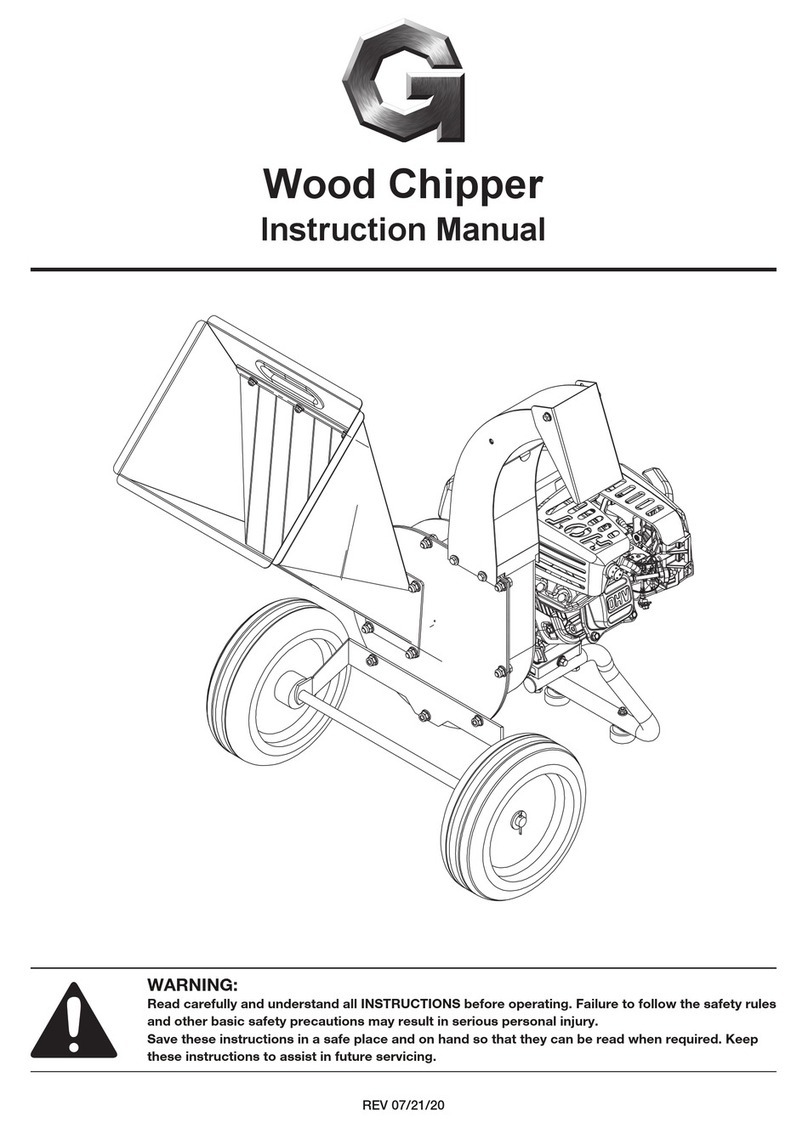
Great Circle
Great Circle GUO054 instruction manual

Craftsman
Craftsman 247.79585 owner's manual

Echo
Echo CH8540 Specification sheet

Farmi Forest
Farmi Forest VALBY CH140 L Operation, maintenance and spare parts

W-W Grinder
W-W Grinder renegade 250 owner's manual
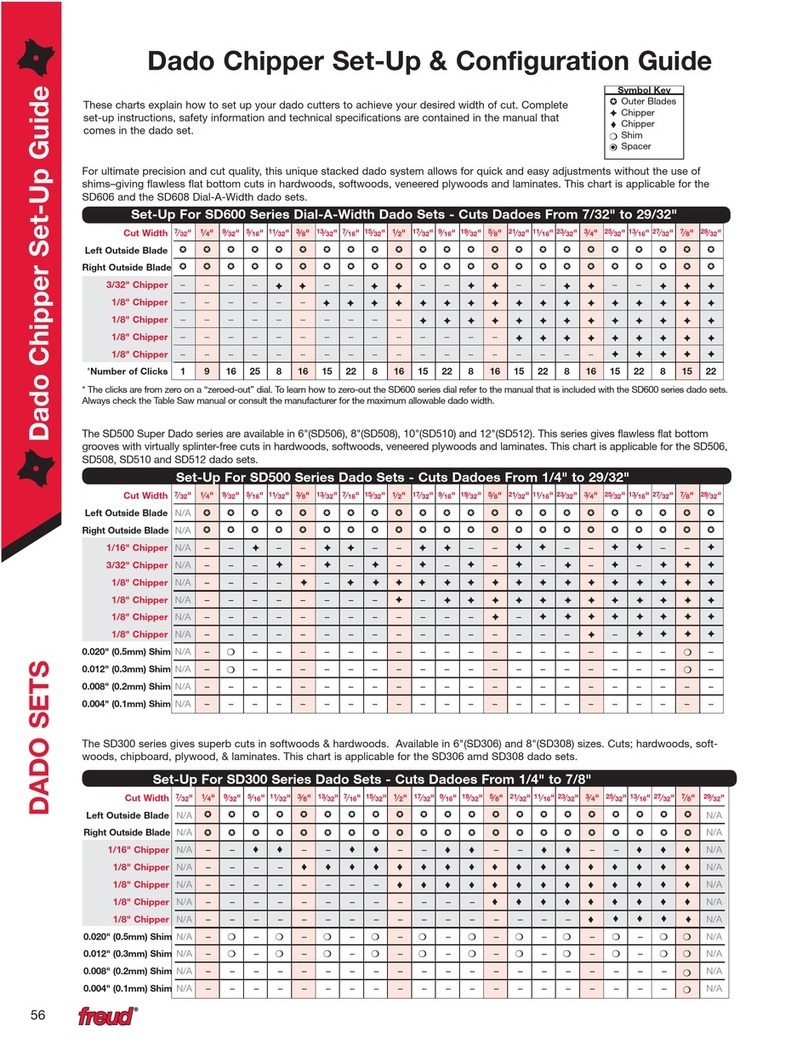
Freud
Freud SD200 Series Setup and configuration guide

Timberwolf
Timberwolf TW 230HB (Diesel) instruction manual

Wahl
Wahl 9649LP Product guide

Craftsman
Craftsman 79964 owner's manual
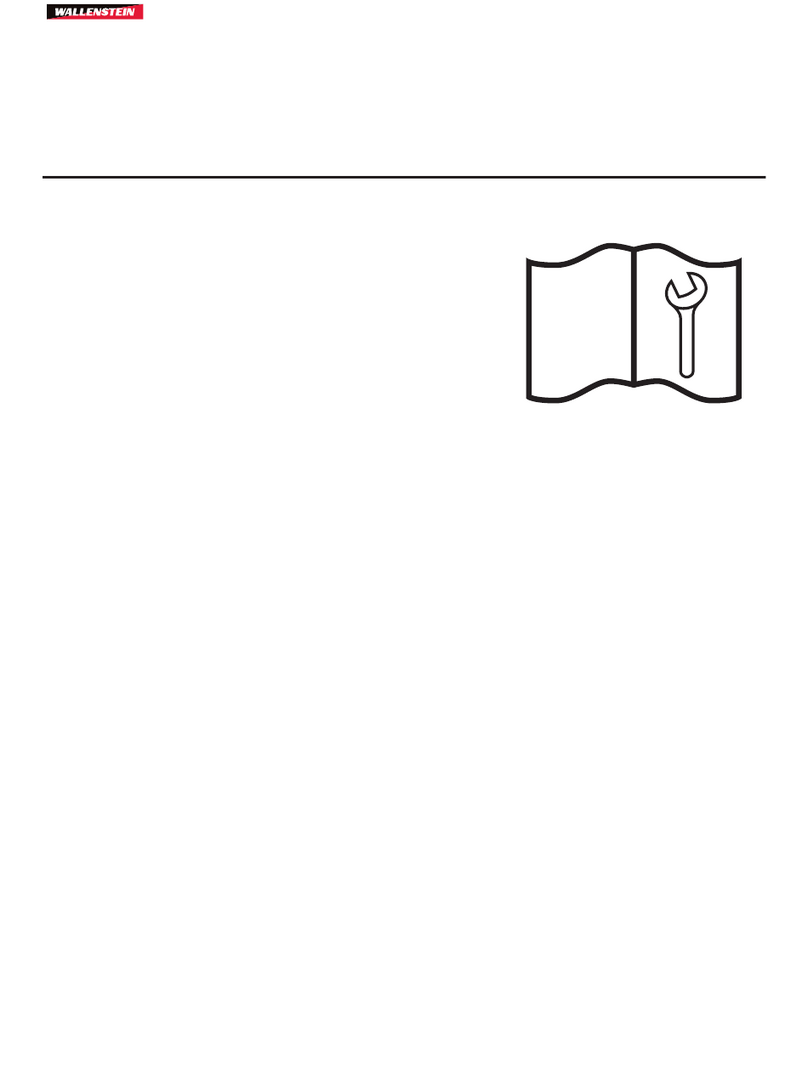
Wallenstein
Wallenstein BXMT32G Setup instructions
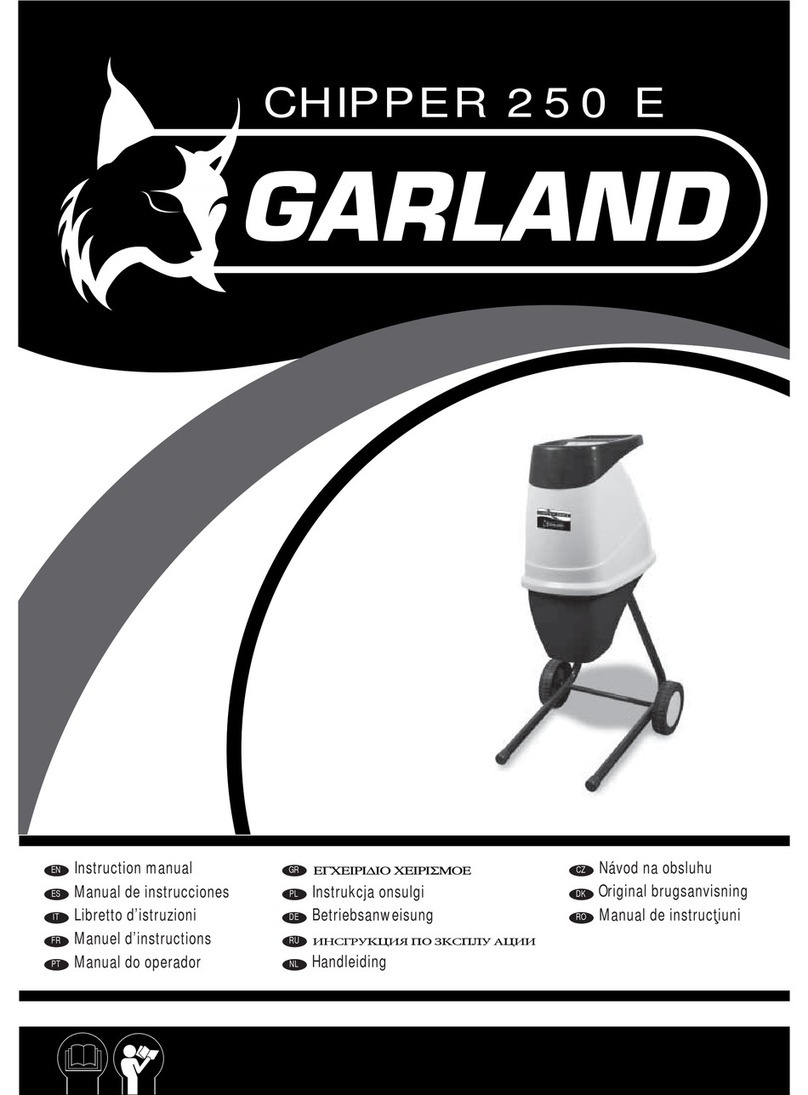
Garland
Garland 250 E instruction manual

Farmi Forest Corporation
Farmi Forest Corporation 100F OPERATION, MAINTENANCE AND SPARE PARTS MANUAL
